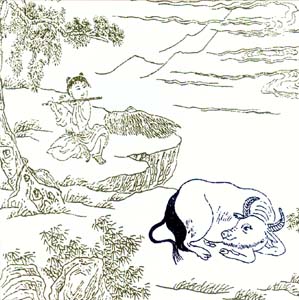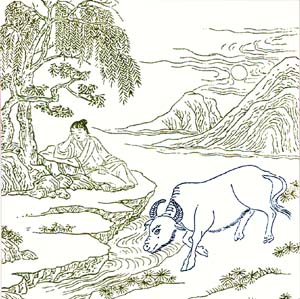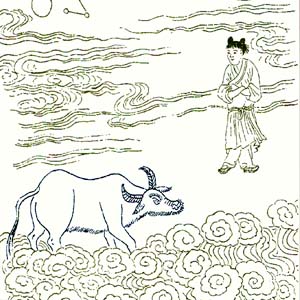ZEN IRODALOM ZEN LITERATURE
« Zen index
« Home
八牛圖 Baniu tu
Version du dressage du buffle en huit tableaux
de 佛國惟白 Foguo Weibai [Bukkoku Ihaku]
(12e siècle)








Cette version mentionnée dans
Le chemin de l'éveil, illustré par le dressage du buffle dans le bouddhisme Chan, le dressage du cheval dans le taoïsme, et le dressage de l'éléphant dans le bouddhisme tibétain,
par Catherine Despeux
Paris, éd. l'Asiathèque, 1981 (réimpr. 1992; 2015), p. 66.Cette version en huit tableaux est simplement mentionnée dans le 請益錄 Qingyi lu.*
Il y est seulement précisé que les buffles des quatre premiers tableaux sont blancs,
tandis que ceux des quatre derniers tableaux sont noirs [Des images adaptées au contexte].
佛國惟白 Foguo Weibai (12e siècle) appartenait à l'école de Yunmen.* Titre abrégé de 萬松老人評唱天童覺和尚拈古請益錄 Wansong laoren pingzhang Tiantong Jue heshang niangu qingyi lu
écrit par 正覺 Zhengjue (1091-1157) et 行 秀 Xingxiu** (1166-1246) de l'école Cao Dong (曹洞宗).
http://www.cbeta.org/result/normal/X67/1307_001.htm** 萬松行秀 Wansong Xingxiu (1166-1246), alias 萬松野老 Wansong Yelao
Wansong wrote two important commentaries on kōan compiled by Hongzhi Zhengjue (1091–1157). In 1224 he published a commentary to a collection of one hundred songgu (頌古) kōan by Hongzhi under the title Congrong Lu (從容錄), known in English as the Book of Equanimity or the Encouragement (Hermitage) Record. Wansong's commentary edition ensured the survival of Hongzhi's kōan, and came to be regarded as one of the seminal texts of the Caodong school. Wansong also wrote a commentary on Hongzhi's niangu (拈古) kōan, entitled Qingyi Lu (請益錄), known in English as Record of Seeking Additional Instruction. He also wrote a collection of sayings entitled Wanshou Yulu (萬壽語錄), with a preface dated 1235.
https://en.wikipedia.org/wiki/Wansong_Xingxiu